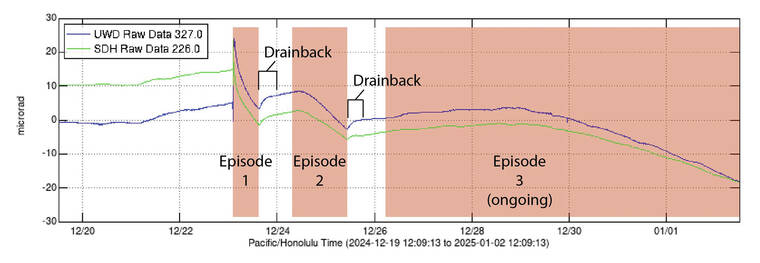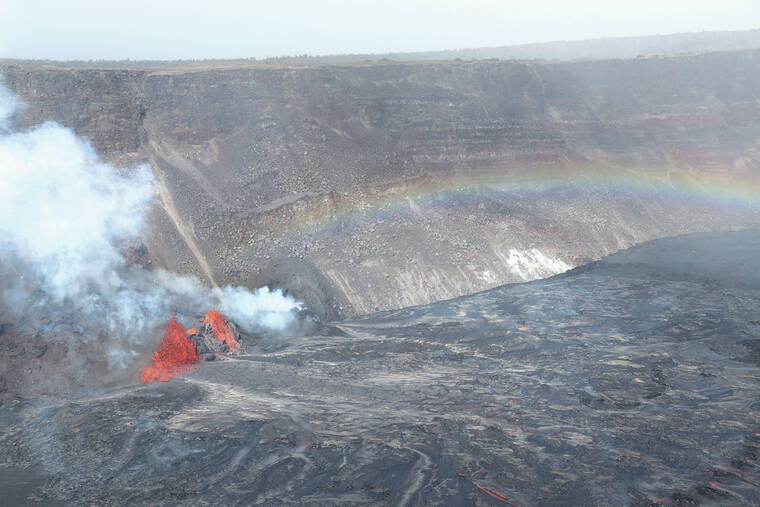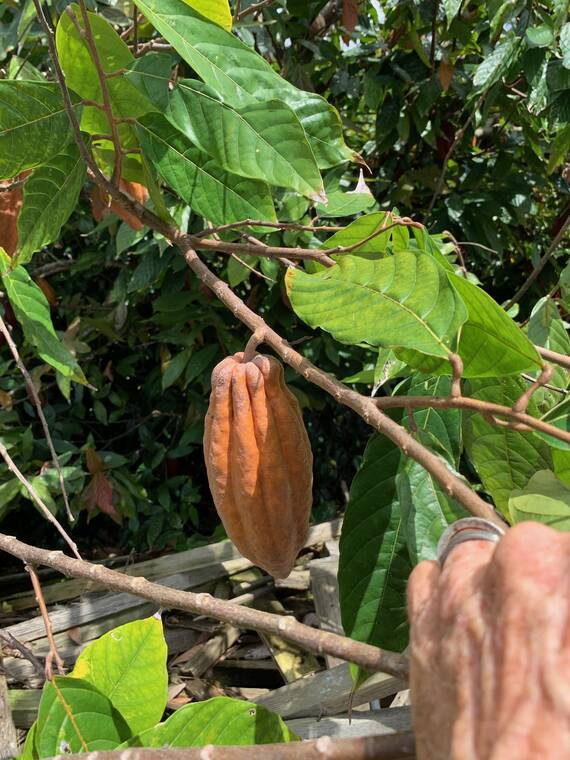Volcano Watch: Happy New Year, Hawaiian style
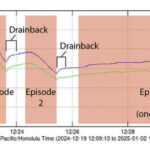
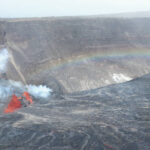
People around the world greet the New Year with fireworks and other celebrations. This year, Hawaii Volcanoes National Park visitors greeted the New Year with displays of lava fountaining from the southwest part of Kaluapele, the summit caldera of Kilauea volcano.
The eruption is currently in its third episode, with pauses and resumptions of eruptive activity correlating with the level of pressurization within the magma chambers beneath the summit region of Kilauea. Two important instruments for monitoring the level of pressurization are the UWD and SDH tiltmeters, which measure how the ground is tilting as magma chambers beneath the summit inflate or deflate.
ADVERTISING
Magma chambers beneath Kilauea summit region showed increasing pressurization in the months leading up to the current eruption. Fountains of lava burst from the floor of Halema‘uma‘u at 2:20 a.m. HST on December 23, rapidly reaching heights up to nearly 300 feet (91 meters). These vigorous lava fountains fed lava flows that covered most of the floor of Halema‘uma‘u crater within Kaluapele that dropped during the 2018 caldera collapse, referred to informally as the “downdropped block.”
Lava being erupted on the surface rapidly relieved some of the pressure that had built up in the magma storage areas below Kilauea summit. The summit tiltmeters showed strong deflationary tilt immediately after the eruption began, until about 4 p.m. on December 23, when the lava fountains ceased erupting. At this point, lava began flowing back into the vent, in a phenomenon called “drainback,” and tilting direction at UWE and SDH switched to inflationary. This indicated that pressure was again building in the magma chambers beneath Kilauea summit.
Inflationary tilt continued overnight, and lava began slowly erupting again around 8 a.m. HST on Christmas Eve, December 24. At about 11 a.m. HST, lava fountaining resumed and tiltmeters once again began measuring rapid deflationary tilt during this second episode of the eruption, which continued for the next 24 hours. Lava flows again covered most of the lower elevation southwest portion of Kaluapele floor and the eruption abruptly stopped again around 11 a.m. on Christmas Day, December 25.
Just as they did during the earlier pause, summit tiltmeters began measuring inflationary tilt, indicating that pressure was again accumulating in the magma chambers. Inflation continued through the following night until the eruption resumed at 8 a.m. HST on December 26. Slow lava flows remained close to the vent until the evening of December 27, when low-level lava fountaining resumed. Lava fountaining gradually increased in vigor as slow inflation continued until the afternoon of December 29. Since then, Kilauea summit tiltmeters have continued to measure deflationary tilt with lava fountaining feeding lava flows in the southwest portion of Halema‘uma‘u.
This interplay of eruption episodes and variations in magma chamber pressure leads to lots of questions. Most of all: “Why has the eruption been stopping and starting so dramatically?” The association of drainback with magma chamber inflation is puzzling; one would expect increased eruption rate if pressure is increasing.
The answer may lie in the gas content of lava and extent to which gas bubbles also drive eruption. Like releasing the cap off a soda, opening a eruptive vent can result in a combination of pressure- and bubble-driven flow. Erupted lava that “drains back” into the vent is much denser than the fresh gas-rich lava. The drainback lava forms a plug, like putting a cork back into a champagne bottle, that allows the magma chamber to repressurize. The dense lava is slowly pushed out at the beginning of the next episode until new, gas-rich lava gets close enough to the surface to vesiculate and restart fountaining.
The third episode of the eruption is ongoing as of this writing. The USGS Hawaiian Volcano Observatory (HVO) continues to closely monitor the activity, and views of the activity are available on HVO webcams, including a livestream camera.
The recent eruption is a reminder that in Hawaii we live on the flanks of volcanoes, some of which are active. Volcano Awareness Month is a great opportunity for you to increase your knowledge of volcanic activity in Hawaii — join us at one of the many events being offered on the island of Hawaii throughout the month of January and don’t forget to submit your art or poetry to our contest! Learn more here: https://tinyurl.com/mtjpybmr.
Volcano activity updates
Kilauea is erupting. Its USGS Volcano Alert level is ADVISORY.
Over the past week, vents in the southwest portion of the caldera have continued producing lava flows covering the western portion of the crater floor during sustained lava fountaining. Eruptive activity has been confined to Halema‘uma‘u and the down-dropped block within the caldera. No unusual activity has been noted along Kilauea’s East Rift Zone or Southwest Rift Zone.
Sulfur dioxide emission rates are elevated in the summit region during eruptive activity. Earthquake rates in the Southwest Rift Zone and upper to middle East Rift Zone remained comparable to the previous week. Ground deformation rates outside of the summit region remained steady.
Mauna Loa is not erupting. Its USGS Volcano Alert Level is at NORMAL.
Five earthquakes were reported felt in the Hawaiian Islands during the past week: a M3.1 earthquake 10 km (6 mi) E of Pahala at 30 km (18 mi) depth on January 1 at 10:51 a.m. HST, a M2.6 earthquake 2 km (1 mi) WSW of Pahala at 31 km (19 mi) depth on December 30 at 1:06 a.m. HST, a M2.7 earthquake 2 km (1 mi) WSW of Pahala at 32 km (20 mi) depth on December 29 at 11:35 p.m. HST, a M3.7 earthquake 2 km (1 mi) SW of Pahala at 30 km (18 mi) depth on December 29 at 11:19 p.m. HST, and a M4.3 earthquake 1 km (0 mi) WSW of Pahala at 30 km (19 mi) depth on December 29 at 11:04 p.m. HST.
HVO continues to closely monitor Kilauea and Mauna Loa.
Please visit HVO’s website for past Volcano Watch articles, Kilauea and Mauna Loa updates, volcano photos, maps, recent earthquake information, and more. Email questions to askHVO@usgs.gov.

